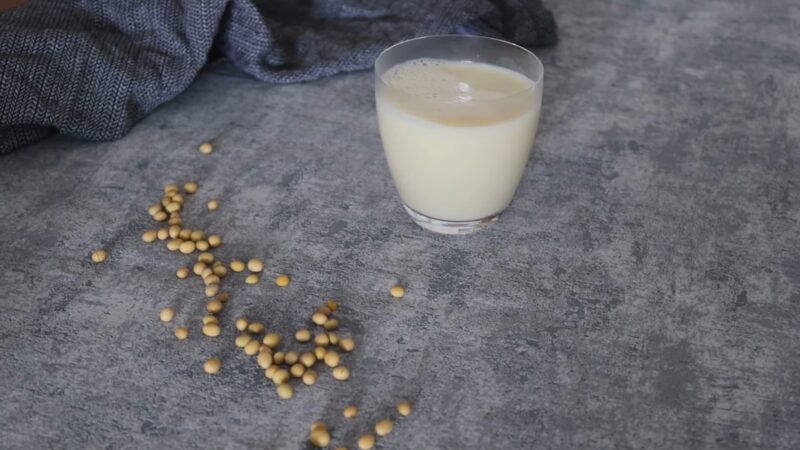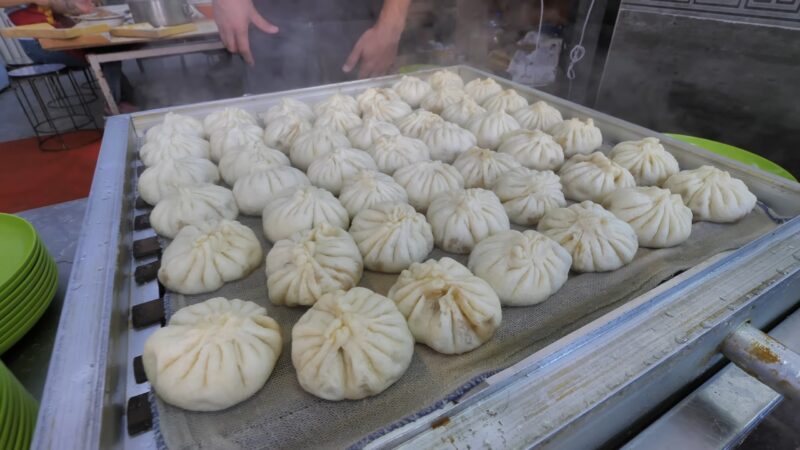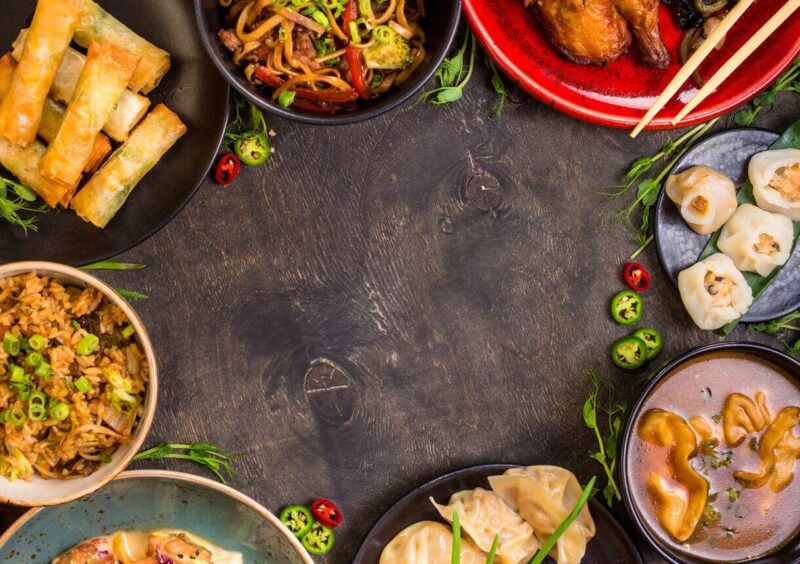When it comes to the diverse world of culinary traditions, Chinese cuisine stands out for its rich flavors, varied ingredients, and unique cooking techniques.
A question that often arises among food enthusiasts and those with dietary restrictions is: does Chinese food contain dairy? We will analyze more about that in the following sections.
Use Of Dairy Throughout Chinese History

Traditionally, Chinese cuisine has been characterized by a minimal use of dairy products. This is partly due to historical, geographical, and cultural factors. In ancient China, the diet primarily revolved around staples like rice, soy, wheat, vegetables, and meat. It was not a common ingredient in the diet of most Chinese regions.
The historical absence can be traced back to agricultural practices. Unlike in Western cultures, where dairy farming became a cornerstone of food production, in China, the focus was more on crop farming and horticulture. Livestock was primarily used for labor rather than milk production. This agricultural trend influenced dietary habits, leading to a cuisine that rarely featured any milk-based products.
Another factor is the prevalence of lactose intolerance among the Asian population. Studies have shown that a significant percentage of the Asian population is lactose intolerant, which naturally led to a diet low in dairy products. This biological factor played a crucial role in shaping the traditional Chinese diet.
On the other hand, certain nomadic tribes in northern China and in regions like Tibet and Inner Mongolia did incorporate dairy into their diets. These areas, with their strong pastoral traditions, made use of milk, yogurt, and cheese from yaks and other livestock. But these practices were more of an exception than the norm in the broader spectrum of Chinese culinary history.
Dairy Ingredients in Modern Chinese Cooking
In contrast to its historical roots, modern Chinese cuisine has seen a gradual incorporation of dairy, especially in urban areas and in fusion dishes. This shift is partly influenced by global culinary trends and the increasing availability. However, it’s important to note that it is still not a central ingredient in Chinese cooking.
As families explore these modern culinary trends, teaching young ones the traditional art of handling chopsticks can enhance their appreciation for cultural practices, blending the old with the new in a harmonious dining experience.
Common Dairy Products
- Cheese: Unlike Western cuisines, cheese is not a staple in Chinese cooking. However, some modern Chinese recipes, especially those that blend Eastern and Western styles, might include cheese.
- Milk and Cream: Milk is occasionally used in certain desserts and baked goods. Cream, though not traditional, can be found in some contemporary Chinese dishes that cater to a more Westernized palate.
- Yogurt: Yogurt has found its way into some Chinese cuisines, particularly in marinades or as a base for sauces in certain regional dishes.
Regional Variations

- Northern China: In regions like Inner Mongolia, products like milk and yogurt are more common due to the historical presence of nomadic cultures.
- Western China: In Tibetan cuisine, butter and cheese made from yak’s milk are traditional ingredients.
- Coastal Cities: In cosmopolitan areas like Shanghai and Beijing, Western influences have led to a more prominent presence of dairy in various forms.
Popular Chinese Dishes With Dairy
While traditional Chinese dishes rarely contain it, there are a few exceptions, especially in modern interpretations.
Dishes Commonly Including Dairy
- Milk-based Desserts: Some Chinese desserts, influenced by Western cuisine, might include milk or cream. Examples include milk custards and some types of sweet soups.
- Fusion Dishes: In urban and tourist areas, you might find Chinese dishes that incorporate cheese or cream, blending Eastern and Western culinary traditions.
| Dairy Food/Recipe | Description |
|---|---|
| Rubing (乳饼) | A cheese from Yunnan province, similar to paneer or cottage cheese. It’s often fried or grilled and served with a sweet or spicy dipping sauce. |
| Milk Tea | Popular in various regions, Chinese milk tea includes black tea with added milk, often sweetened. It’s a staple in Hong Kong and other parts of China. |
| Milk Custard (双皮奶) | A Cantonese dessert made from milk, egg whites, and sugar, known for its smooth texture. It’s a double-layered custard, often served chilled. |
| Tibetan Butter Tea | A traditional Tibetan drink made from tea leaves, yak butter, and salt. It’s a rich, creamy tea that’s an integral part of Tibetan culture. |
| Mongolian Milk Tea | A traditional beverage in Inner Mongolia, made with milk, tea leaves, and sometimes salt. It’s less sweet than typical milk tea and often consumed daily. |
| Sweetened Yogurt (甜酸奶) | A popular snack in Beijing, this sweetened yogurt is often sold in ceramic pots. It’s creamy with a slightly tangy flavor, typically eaten cold. |
Alternatives Are More Common
For those who are lactose intolerant or prefer dairy-free diets, Chinese cuisine offers many alternatives.
Non-Dairy Alternatives Used

- Soy Milk: A common substitute for cow’s milk in various recipes.
- Tofu: Used in place of cheese or cream in some dishes.
- Coconut Milk: Occasionally used in some Southern Chinese and fusion dishes.
Adaptation to Dairy-Free Requirements
- Traditional Cooking: Most traditional Chinese recipes are naturally dairy-free, requiring no modification.
- Modern Adaptations: Contemporary Chinese chefs often create dairy-free versions of fusion dishes, ensuring they cater to a wide range of dietary preferences.
Health and Dietary Considerations
The prevalence of lactose intolerance in the Chinese population has a significant impact on the cuisine.
Understanding the proper storage and shelf life of these dishes is crucial for their freshness and safety, particularly when dairy elements are introduced.
Lactose Intolerance in China
- Prevalence: A high percentage of the Chinese population is lactose intolerant, influencing the traditional low dairy content in the cuisine.
- Dietary Impact: This has led to a cuisine rich in other sources of nutrition, focusing on vegetables, grains, and meats.
Influence of Western Cuisine

- Western Influence: The growing popularity of Western-style cafes and bakeries in China has introduced more dairy into Chinese diets, particularly in urban areas.
- Fusion Foods: Dishes that blend Chinese and Western culinary traditions often incorporate dairy, such as cheese-topped baozi or creamy sauces in stir-fries.
FAQs
Can I find traditional Chinese cheese varieties in international markets?
Traditional Chinese cheeses like Rubing are not commonly found in international markets due to their regional specificity and limited production. However, in areas with significant Chinese communities, specialty Asian markets might stock them or similar alternatives.
Are there any Chinese desserts that traditionally include cheese?
Traditional Chinese desserts rarely include cheese. However, modern fusion desserts, such as cheesecake with Chinese flavor infusions (like green tea or lychee), are becoming more popular in urban areas and fusion cuisine.
How do Chinese restaurants typically respond to dairy-free dietary requests?
Most Chinese restaurants are accustomed to accommodating dietary restrictions, including dairy-free requests. Since traditional Chinese cuisine rarely includes dairy, it’s usually easy to find or request dairy-free options.
Is soy milk used in traditional Chinese cooking, or is it a modern addition?
Soy milk has a long history in Chinese cuisine and is not a modern addition. It has been used for centuries, primarily in beverages and some traditional dishes, often as a dairy alternative.
Has the introduction of Western dairy products changed any traditional Chinese recipes?
While traditional recipes remain largely unchanged, the introduction of Western dairy products has led to the creation of new, fusion-style dishes in Chinese cuisine. For example, some bakers might use butter in traditional Chinese pastries, or cream might be added to give a twist to classic sauces.
Last Words
While traditional Chinese cuisine largely avoids the use of dairy, modern culinary practices have introduced some dairy elements, particularly in urban and fusion cooking. However, the core of Chinese cooking remains largely dairy-free, making it an excellent option for those with lactose intolerance or a preference for dairy-free diets.
Stay with us at Lauhound to learn a lot of interesting topics from different areas.
